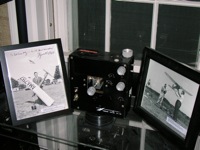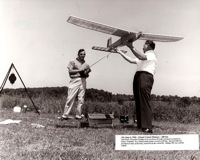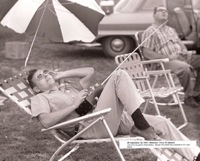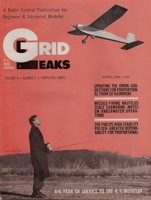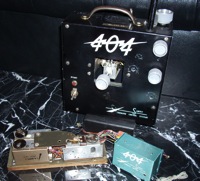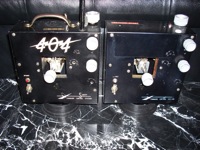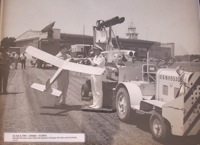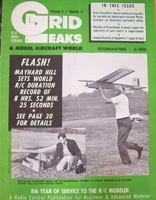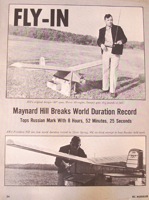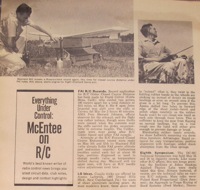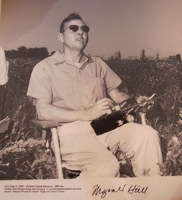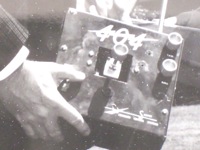Special Exhibit:
Maynard Hill’s Sampey 404s
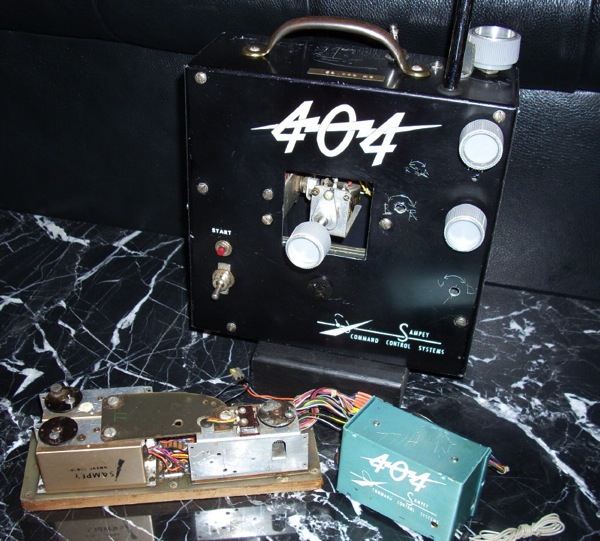
(Click on any of the images on this page to see a larger version)
This was Maynard Hill’s first Sampey 404—the most famous Sampey in history. This recent acquisition was discovered in Quebec where it was “lost” for decades. Read below how final proof that our radio was truly Maynard Hill's famous one was "handed" to us by the world's first RC Pilot--through the mists of time.
Since 2006, Maynard Hill’s second 404—not this one—has been at the center of our main display. So we’ll begin here with our account of No. 2, exactly as written years ago, then follow with the story of No. 1.
Maynard Hill’s 404 No.2
This is Maynard Hill’s Sampey 404 which he used to set World Records in the 1960s. He was a model aviation pioneer and leader and an AMA President, but above all he was the King of the World Records. We doubt anyone else was so successful at making and breaking world records, at least not back then. His historic accomplishments continued over the years, the most recent being his transatlantic model airplane flight in 2003, at a time when he was legally blind.
Maynard Hill lived in the DC area and was prominent in his local RC club, DCRC. But DCRC was no ordinary club. What the legendary German Bauhaus was to architecture, the DCRC was to radio control development. Each year DCRC hosted Symposia and the “best and brightest” would come from around the country and present sophisticated technical papers. The DCRC was the avant-garde, the cutting edge of the industry and Maynard Hill was at its forefront.
Maynard began his assaults on the record books in the early 1960s after learning how the existing Russian record holder achieved his records with relatively crude equipment. Maynard Hill thought he could do better with superior American aircraft, engines and radios. In addition to this equipment and his own formidable skills in model designing and building, electronics and piloting, Maynard Hill had incomparable leadership abilities which enabled him to assemble the necessary teams of people to back him up and assure success. In those cold war days beating the Russian record holders was more than a personal triumph, it was a point of patriotic pride for modelers around the country.
Maynard Hill pursued the Third Dream of Radio Control from an early date. He transitioned from single channel escapement radios to crude pulse/mechanical systems then to the TTPW system of his good friend Walt Good, then to Space Control. When he began his world record attempts he used the most promising new system of that day – the Sampey 404. Maynard Hill employed two 404’s in his record attempts using one as a backup or alternating back and forth between the two (especially on duration and distance flights).
The cost of two Sampey 404s in today’s terms would approach ten thousand dollars. Maynard purchased them, with his own funds to maintain his detachment, although Sampey may have been willing to give him the radios in hopes of favorable publicity. Only the truly dedicated, determined to have the very best, would spend such a sum on model airplane radios but this was only the beginning of Maynard Hill’s expenditure of time and money in his quest. In the end it all paid off, and Maynard Hill assumed his well-earned place in model aviation history. And oh yes, Harry Sampey got that favorable publicity and shrewdly parlayed it into 404 sales. See Sampey section.
Maynard Hill’s other Sampey 404, had the trademark “404” insignia at the top but on this one only a faint vestige of these numbers is visible. Here is a picture of Maynard and John Worth preparing to break the closed course distance record with the transmitter visible in the background. Maynard Hill was President of the AMA at this time.
Here is a tired, reclining Maynard Hill using this transmitter to break the word duration record. If you look closely you can see some of the distinctive features including the hand cut relocation of the throttle control and the wiring to draw power from a car battery. Other distinctive features on our transmitter include the 2 tiny push buttons on the right side (visible in the previous picture), the name “Hill” etched through the finish and the many technical scratch marks (arrows, letters, etc) to aid tuning and operation. This worn transmitter was as well used as it was used well.
Here is the cover of the March/April 1964 Grid Leaks picturing Maynard Hill using our transmitter in early season practice for the closed course distance record. The white noteboard or plaque at the top is the likely reason this transmitter lost its “404”. Maynard does not recall how this happened. We surmise that the whiteboard was secured with glue, 2-sided tape or the like, and when it was pulled off most of the 404 insignia came off with it (and the rest may have then been removed to “even things up”). If anyone has additional information about how this 404 lost its“404” please contact us.
Maynard Hill’s 404 No.1
This was Maynard Hill’s first Sampey 404, which he designated number ”1”. As you can see here, he scratched “1” and “2” on the top of each. The airborne system here is the last version he used in 1965 before retiring his 404s. The servos are the early Don Steeb variety but the receiver is a later blue model not the gold-case original used for the first World Records.
World Altitude Record
On July 4, 1963, Independence Day, Maynard Hill used this costly, troubled, trailblazing 404 radio to “beat the Russians” and win back the World Altitude Record for the United States. In that cold war era, when the U.S. and Soviet Union were arch enemies and the threat of Nuclear War lurked in the background, Hill’s feat was a source of patriotic pride. To top it off, he didn’t just beat the Russians, he almost doubled their record.
Here’s the Model Airplane News account (Oct 63 MAN):
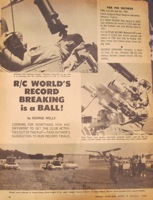 | 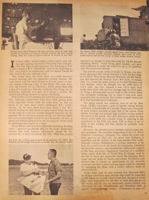 |
Note how Hill not only assembled a top team of volunteers, he also enlisted major military equipment and support. Without the huge military radar and optical tracker he would have been unable to even see his plane at that altitude.
Here’s part of Grid Leak’s coverage of this feat (Sept-Oct 63 GL):
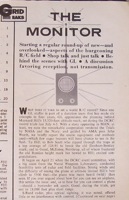 | 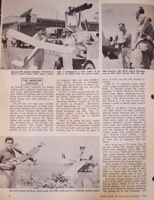 |
Sampey promptly emblazoned his 404 ads with this banner celebrating the Hill/Sampey achievement (Sept-Oct 63 AM): This was the turning point for Sampey, boosting sales and enabling his small company to become profitable for the first time.
Others tried to share the spotlight with Maynard Hill. Here is SIG’s advertisement, for example (Nov/Dec 63 AM): You can see all this better in this original 8 x 10 glossy used by the magazines:
World Duration Record
On September 18, 1964, Maynard Hill broke the World Duration Record. This Grid Leaks cover marks the event, which required both 404 No. 1 and No. 2 (Sept-Oct 64 GL):
You can tell the transmitter pictured here is No. 1 since No. 2 had its elevator trim knob on the side in the lower position. Here is Radio Control Modeler’s coverage (Nov 64 RCM):
These 8 x 10 glossies provide a clearer picture. For identification purposes we already see several of the final characteristics of this transmitter on its top. Note the micro switch, the off-center handle and the frequency sticker applied at an angle to the front of the case.
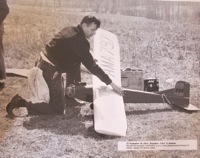 | 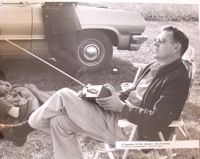 |
Closed Course Distance
On June 2, 1965, Maynard Hill broke the world closed course distance record using this radio. Here is the American Modeler story (Sept/Oct 65 AM): Both pictures show his 404 No. 1. Even more impressive, was this lavish spread in Radio Control Modeler (Aug 65 RCM):
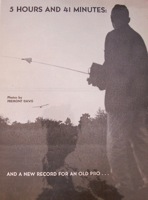 | 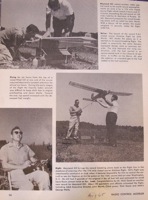 | 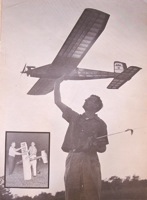 |
In this 8 x 10 original of the published pictures you can see how further modifications by this date brought the transmitter to nearly its final configuration. Note the micro switch above the elevator trim on the side and the angle stop mechanism for the large (throttle) knob on the top. The Maynard Hill name tag is also visible in the photo, but has since been removed by someone from No. 1 leaving only “YNARD H” barely visible today in the residual adhesive residue. His name is also scratched into the receiver case.
In Good Hands
Final proof that our radio was truly Maynard Hill's famous one was "handed" to us by the world's first RC pilot--Walt Good. Here's Walt Good when his historic 1937 RC plane was drafted into the Smithsonian. And here's Walt Good handing us the final clue.
If you look closely, final identification is possible since the face of the transmitter in Walt Good’s hands has the identical crude, scratched-in curved markings above the master (neutral changing) control holes for engine and aileron (left of knobs) and elevator (beneath knobs).
These scratchings and enlarged adjustment access holes, on both of his 404s, speak loudly about the drifting neutrals and other shortcomings of early proportional systems. This makes Hill’s accomplishments all the more remarkable.
BINGO!
When we compared our 404 to a magnification of this photo we knew we had the real thing.
 |
Links to Sampey Company History and First 404



